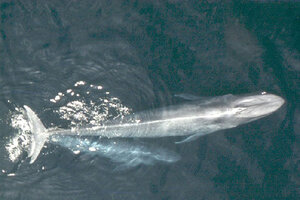Once on brink of extinction, West Coast blue whales stage a comeback
Once nearly driven out of existence by whalers, the Earth's largest animals have rebounded to about 97 percent of historical levels, say scientists.

Blue Whales are seen in this undated handout photo courtesy of NOAA National Marine Fisheries Service. California blue whales, the largest animals on Earth once driven to near extinction by whaling, have made a remarkable comeback to near historic, 19th-century levels, according to a University of Washington study released on September 5, 2014.
NOAA National Marine Fisheries Service/Reuters
Los Angeles
California blue whales, the largest animals on Earth once driven to near extinction by whaling, have made a remarkable comeback to near historic, 19th-century levels, according to a University of Washington study released on Friday.
The recovery makes California blue whales - which study authors say now number about 2,200, or 97 percent of historical levels - the only population of blue whales known to have recovered from whaling.
"The recovery of California blue whales from whaling demonstrates the ability of blue whale populations to rebuild under careful management and conservation measures," said Cole Monnahan, a University of Washington doctoral student and lead author of the study.
Despite the comeback, the whales - which as adults can reach nearly 100 feet (30 meters) in length and weigh 190 tons (172 tonnes), twice as much as the largest known dinosaur - are still being struck by ships off the California coast at numbers above allowable U.S. limits, according to the study's authors
Conservation groups say at least 11 blue whales are struck each year along the U.S. West Coast, nearly four times the "potential biological removal" level of 3.1 permitted under the U.S. Marine Mammal Protection Act.
"Even accepting our results that the current level of ship strikes is not going to cause overall population declines, there is still going to be ongoing concern that we don't want these whales killed by ships," University of Washington assistant professor of aquatic and fishery sciences Tim Branch said.
According to the University of Washington paper and a separate paper published earlier this year, some 3,400 blue whales were caught between 1905 and 1971, a number determined in part by examining once-secret Russian whaling archives.
The study's authors say that the population of California blue whales is now growing more slowly, partly due to ship strikes and also because numbers are reaching the habitat limit.
"Our findings aren't meant to deprive California blue whales of protections that they need going forward," Monnahan said.
"California blue whales are recovering because we took actions to stop catches and start monitoring. If we hadn't, the population might have been pushed to near extinction - an unfortunate fate suffered by other blue whale populations," he said. "It's a conservation success story."
(Reporting by Dan Whitcomb; Editing by Sandra Maler)

